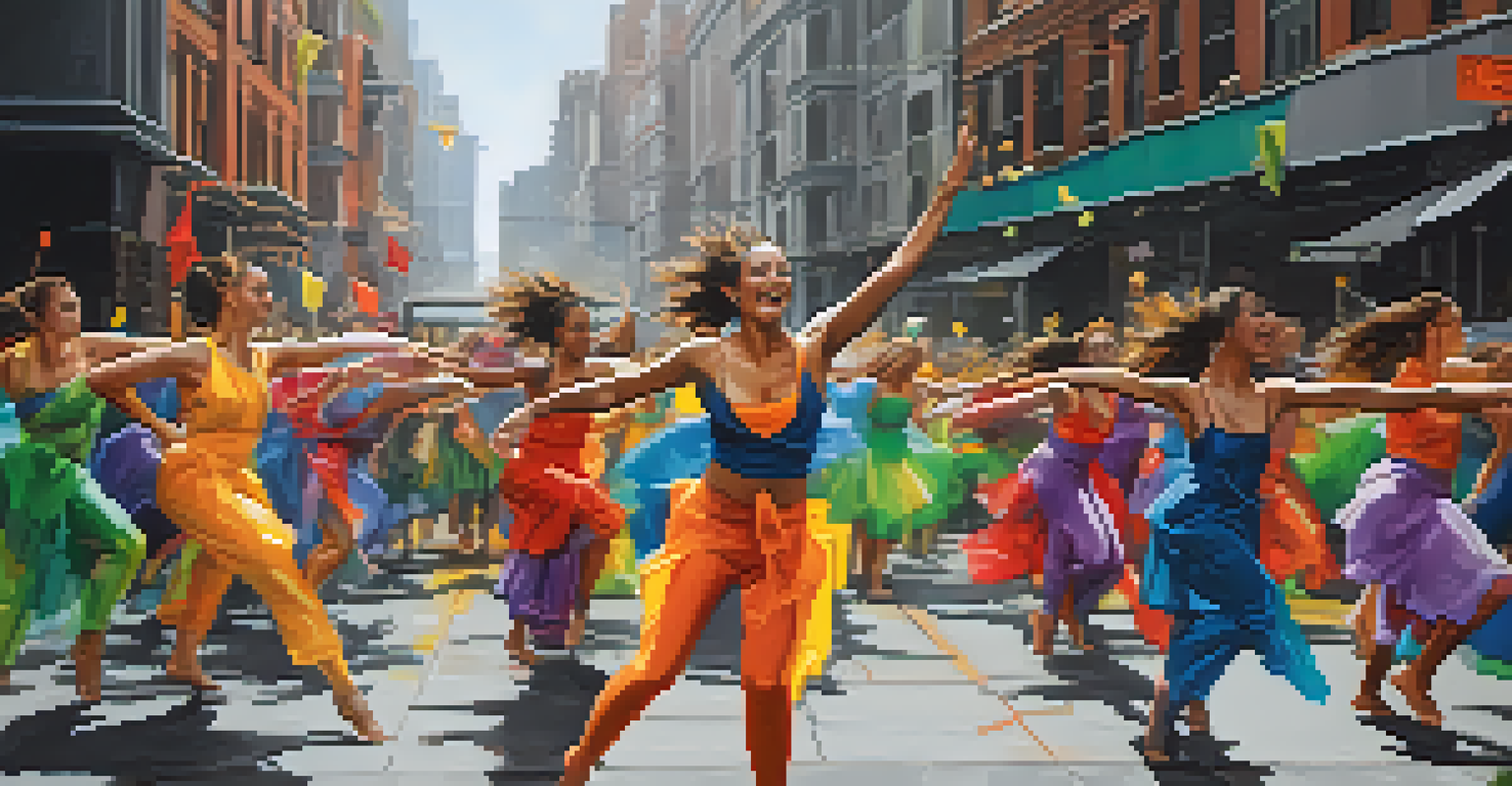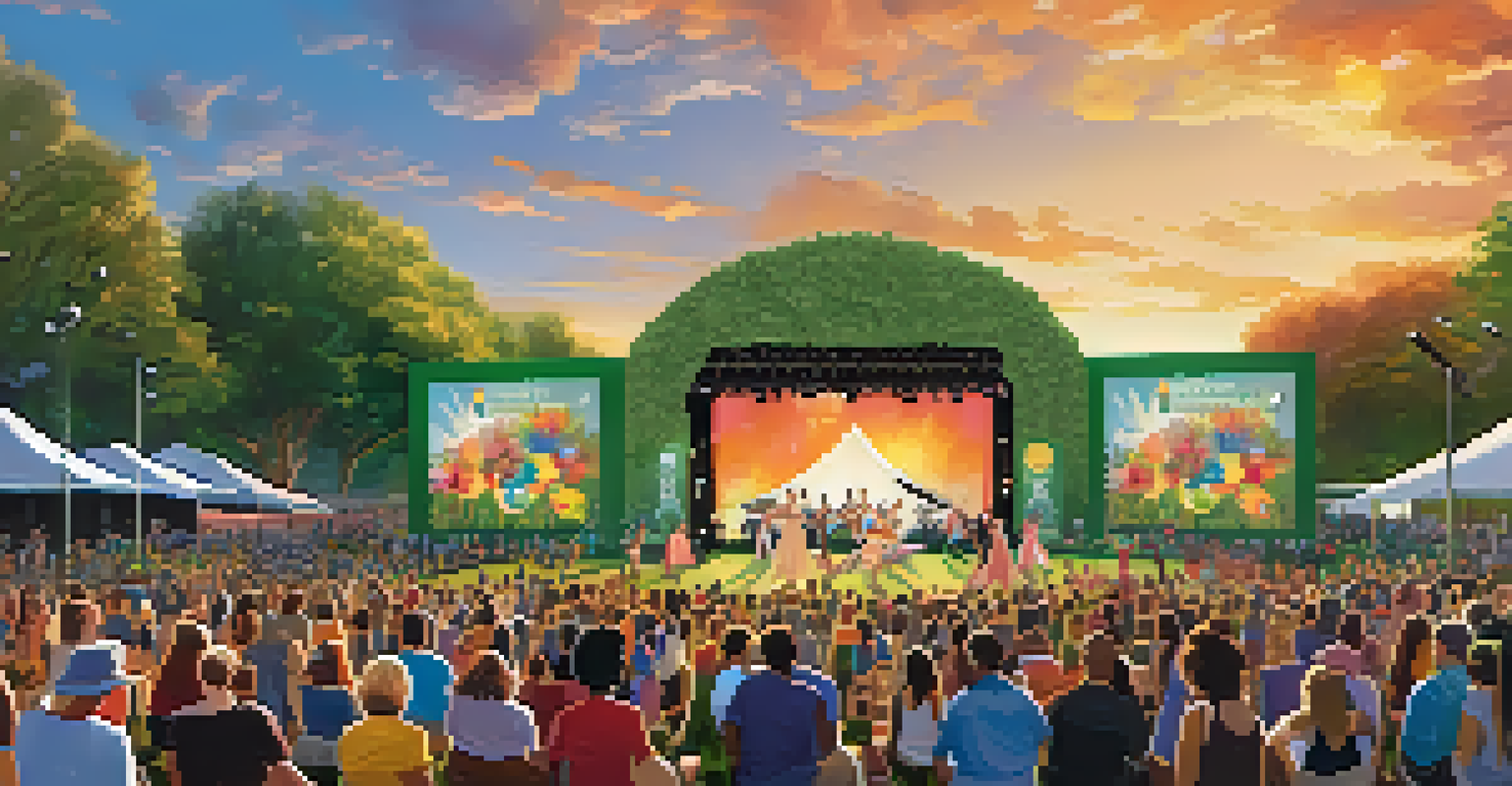Dance as a Tool for Environmental Activism and Education

The Intersection of Dance and Environmental Activism
Dance has long been a powerful form of expression, transcending language and culture. It can convey emotions and messages in ways that words sometimes cannot, making it an ideal medium for environmental activism. By using movement, dancers can illustrate the beauty of nature while also highlighting the urgent need for its protection.
Dance is the hidden language of the soul.
Imagine a performance that mimics the gentle sway of trees in the wind or the chaotic movement of a natural disaster. These physical representations can evoke strong emotional responses, drawing audiences into the narrative of environmental urgency. Through dance, activists can spark conversations that lead to deeper awareness and understanding of pressing ecological issues.
Moreover, incorporating environmental themes into dance performances can engage diverse audiences, from seasoned activists to those new to the cause. This inclusivity can foster a sense of community and shared responsibility toward our planet, inspiring collective action for its preservation.
Dance as a Tool for Education on Environmental Issues
Using dance in educational settings can transform how students learn about the environment. Movement-based learning engages different senses, making complex topics like climate change or biodiversity more relatable and memorable. When students participate in dance, they actively embody the concepts, creating a deeper connection to the material.

For example, a dance that represents the life cycle of a butterfly can teach students about ecosystems and the importance of pollinators. This hands-on approach fosters curiosity and encourages critical thinking about environmental stewardship. As they move, students are not just passive learners but active participants in their education.
Dance Amplifies Environmental Messages
Through movement, dancers can effectively convey the urgency of environmental issues, drawing emotional responses and fostering community engagement.
Furthermore, dance can bridge gaps between cultures and communities, offering a universal language for discussing environmental challenges. It allows students from diverse backgrounds to share their stories and experiences, fostering empathy and a collaborative spirit in addressing global issues.
Creating Awareness Through Dance Performances
Dance performances can serve as powerful platforms for raising awareness about environmental issues. By staging events in public spaces, dancers can reach a wide audience, capturing the attention of passersby and sparking interest in ecological topics. This form of outreach can be both entertaining and educational, making the message more impactful.
We do not inherit the earth from our ancestors, we borrow it from our children.
Consider a flash mob in a park where dancers incorporate movements that depict pollution or climate change effects. Such performances can create a sense of urgency and prompt viewers to reflect on their own environmental footprints. The combination of art and activism can leave a lasting impression, encouraging individuals to take action.
Moreover, these events can be paired with discussions or informational booths, creating opportunities for audience engagement. By providing resources and ways to get involved, dancers can turn awareness into action, motivating the community to advocate for environmental justice.
Dance Festivals Celebrating Environmental Themes
Dance festivals focused on environmental themes can unite artists and activists in a celebration of both art and advocacy. These events often showcase a variety of dance styles, each conveying unique messages about environmental issues. Through vibrant performances, dancers can explore themes such as climate change, conservation, and the interconnectedness of all living things.
Such festivals not only entertain but also educate participants and audiences about pressing environmental challenges. Workshops and discussions can accompany performances, allowing attendees to delve deeper into the issues being highlighted. This multi-faceted approach cultivates a community of informed individuals eager to make a positive difference.
Education Through Movement
Dance-based learning transforms complex environmental topics into relatable experiences, encouraging deeper understanding and stewardship among students.
Additionally, festivals can attract media attention, amplifying the message beyond the immediate audience. When dance is used to advocate for environmental causes, it has the potential to reach a broader audience, raising awareness on a larger scale.
The Role of Social Media in Dance Activism
Social media has become a powerful tool for dance activists, allowing them to share their messages with a global audience. Platforms like Instagram and TikTok enable dancers to showcase their work, creatively weaving environmental themes into their routines. This digital presence can inspire others to engage with environmental activism through dance.
For instance, choreographers can create viral challenges that encourage participants to perform dances centered around sustainability. These challenges not only spread awareness but also foster a sense of community among those passionate about the cause. The mix of creativity and activism can lead to meaningful conversations and actions.
Moreover, social media can connect dancers and activists from different parts of the world, creating a network of individuals dedicated to the same mission. This interconnectedness can amplify efforts and resources, transforming individual actions into a collective movement for environmental change.
Collaboration Between Dancers and Environmental Organizations
Collaboration between dancers and environmental organizations can amplify the impact of both art and activism. By joining forces, dancers can leverage the expertise of these organizations to develop performances that are not only artistically compelling but also scientifically accurate. This partnership ensures that the messages conveyed through dance are rooted in facts and research.
For instance, dancers might work with marine conservation groups to create a performance highlighting the plight of ocean ecosystems. This collaboration can provide dancers with the necessary information to craft authentic narratives that resonate with audiences. The result is a performance that not only entertains but also educates about critical issues.
Social Media Boosts Dance Activism
Platforms like Instagram and TikTok allow dancers to share their environmental messages globally, inspiring collective action and community involvement.
Additionally, such partnerships can lead to fundraising opportunities and initiatives that support environmental causes. By combining the arts with activism, both parties can benefit, creating a powerful synergy that inspires action and change.
The Future of Dance in Environmental Activism
The future of dance in environmental activism looks promising as more artists recognize its potential to inspire change. New generations of dancers are increasingly aware of global issues and are eager to use their craft to make a difference. This evolving landscape encourages creativity and innovation in how environmental messages are conveyed.
As environmental challenges continue to escalate, the urgency for artistic expressions that address these issues becomes even more critical. Dancers may explore new styles, technologies, and platforms to engage audiences effectively. This evolution can lead to more immersive and interactive experiences that captivate and educate.

Ultimately, the fusion of dance and environmental activism will continue to grow, fostering a culture of awareness and action. As artists harness the power of movement to advocate for the planet, they inspire others to join the movement, creating a ripple effect of positive change.